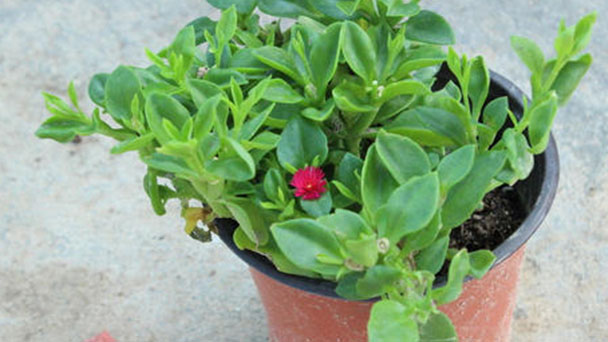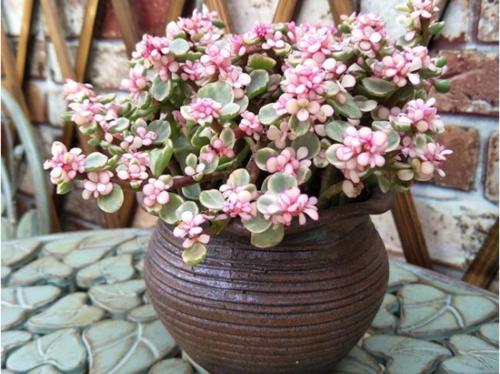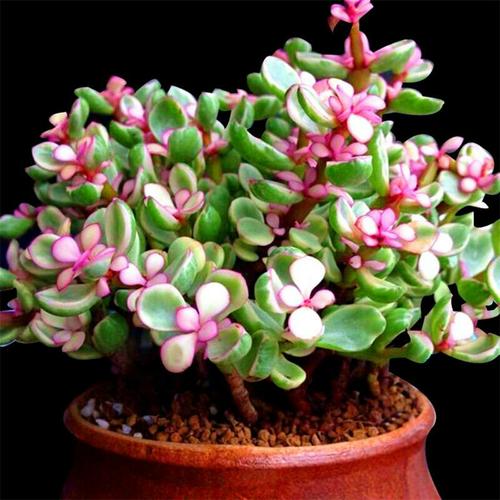How to Care for Elephant Bush
Written by Maggie
Oct 30 2021

Elephant bush plant form is beautiful. Small potted or hanging potted plants are planted, decorating the place such as the sitting room, study and balcony, and windowsill. How to care for elephant bush leaves falling or not blooming? Let's look together.
Elephant bush care for leaves falling
The falling of Elephant bush leaves is related to light, branches and leaves, fertilizer and water. If it is caused by insufficient light or fertilizer, it is necessary to supplement light and fertilizer for Elephant bush in time. If the branches and leaves are dense, the Elephant bush can be pruned or cut. If it is caused by excessive water, the soil should be loosened and drained in time for the Elephant bush. The following are details of elephant bush care for leaves falling.
1. Enough light
Elephant bush likes light and is well suited to growing in full light. During the growth period, in the environment of insufficient light, the leaf growth is poor, and will appear the phenomenon of shedding. When we care for elephant bush, if it is caused by insufficient light, the Elephant bush needs to be moved to an outdoor environment with sufficient light for conservation. Under sufficient light conditions, the Elephant bush can be recovered in the later period.
2. Dense branches and leaves
During the growth of the Elephant bush, its leaves fall off, which may be caused by the overcrowding of branches and leaves. With dense branches and leaves and poor light and air permeability, Elephant bush cannot grow normally and leaves will fall off in large numbers. When we care for elephant bush, if branches and leaves are intensively caused by, we can undertake pruning appropriately, its dense weak branches or weak leaves are cut off, expanding the growth space of branches and leaves.
3. Fertilizer care
During the growth of the Elephant Bush, sufficient fertilizer is required to enable it to grow normally. Lack of fertilizer during growth leaves the Elephant bush chronically short of nutrients, which can dry out, turn yellow or fall off. When we care for elephant bush, if the fertilizer is insufficient, it is necessary to supplement fertilizer for Elephant bush in time. Nitrogen fertilizer is the main fertilizer at the early growth stage and phosphate and potash fertilizer is the main fertilizer before the flowering stage.
4. Water care
Elephant bush is not resistant to waterlogging and needs proper watering during its growth to avoid excessive moisture affecting its normal growth.Over Watering during curing can damage the root system of Elephant Bush and cause leaves to fall off. When we care for elephant bush, if it is caused by too much water, the soil should be loosened and drained in time for the Elephant bush, and water the Elephant bush appropriately in the later stage.

Elephant bush care for not blooming
The non-flowering of Elephant bush is mainly related to light, temperature, nutrients and moisture. If there is insufficient light, the flowering period of Elephant bush will be delayed and it may not blossom. If the temperature is too low, the flowers will be delayed and will not open. If the nutrients are insufficient, the Elephant bush will lack nutrients, which will affect the normal opening of flowers. The following are details of Elephant bush care for not blooming.
1. Enough light
Elephant bush is a perennial evergreen shrub plant of the genus Portulaca in the family Portulaca. It is a light-loving plant and requires sufficient light during its growth. Lack of light, green leaves, delayed flowering, and may not bloom. When we care for elephant bush, if the light is insufficient, the Elephant bush can be moved to a well-lit position, and the leaves will turn purplish red in the late stage.
2. Temperature care
Elephant bush likes temperature and is suitable for growing in a warm, dry and sunny environment. The temperature suitable for Elephant bush growth is between 15 ~ 25 degrees. Elephant bush grows in an environment where temperatures are too low, which can delay the opening time of flowers and cause them to not bloom. When we care for elephant bush, if the Elephant bush grows in a cooler environment, it needs to be moved to a warmer location.
3. Nutrients care
Elephant bush has a high requirement for fertilizer. If there is insufficient fertilizer during the growth period, Elephant bush will lack nutrition for a long time, which will affect the normal opening of flowers. When we care for elephant bush, if the nutrients of Elephant bush are insufficient, fertilizer should be added to Elephant bush in time. Phosphorus and potash fertilizer is the main fertilizer before flowering, and proper watering is needed after fertilization, which can dilute fertility.
4. Water care
Elephant bush has a strong drought tolerance and is not resistant to flooding, but it needs sufficient water during its growth period. If there is insufficient water, the Elephant bush may not flower. When we care for elephant bush, when the Elephant bush is in a state of water shortage, it is necessary to replenish water in time, and in the late stage. It is necessary to water appropriately and keep the soil moist. However, water control is needed during the winter.

Read More:
How to Grow and Care for Elephant Bush
How to Propagate Elephant Bush
Elephant Bush Profile: Characteristics & Uses
Latest Updated
- Benefits of Bugleweed - 7 Science-backed Health Benefits
- Bugleweed Dangers & Side Effects - Is It Poisonous?
- How to Plant Evergreen Trees - What You Should Know
- When to Plant Evergreens - Grow Guide for Evergreen Trees
- 12 Wonderful Evergreen Shrubs for Your Garden
- 12 Popular Evergreen Plants with Pictures for Beginners
- When And How To Prune A Lilac Bush Like a Pro
- How to Grow & Care for Lilac Vine (Hardenbergia Violacea)
- Japanese Lilac Tree (Syringa Reticulata) Care & Propagation Guide
- Shumard Oak Pros and Cons - What to Know
Popular Articles
- Winter maintenance of Antirrhinum Majus
- How to Grow Terminalia Mantaly Tree
- How to Grow and Care for Crossostephium Chinense
- How to grow Antirrhinum Majus in spring
- Peristeria Elata (Dove Orchid) Profile: Info & Care Guide
- Underwatered Snake Plant (Sansevieria Trifasciata) - Signs And How To Fix
- How to Care for Brazilian Jasmine Plant (Mandevilla Sanderi)
- How to Grow & Care for Graptopetalum Purple Delight in Summer
- Rosa Chinensis (China Rose): Plant Growing & Care Tips
- How to Care for Baby Sun Rose (Aptenia Cordifolia)